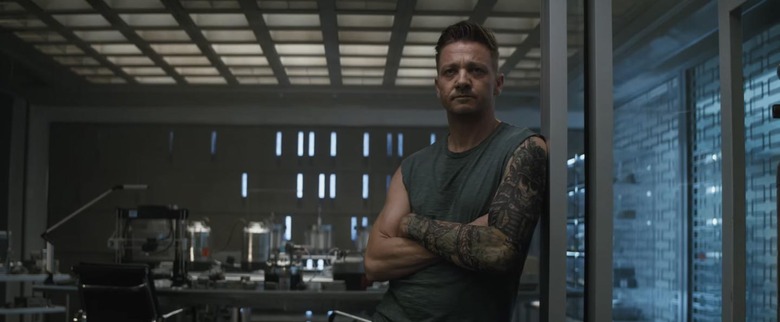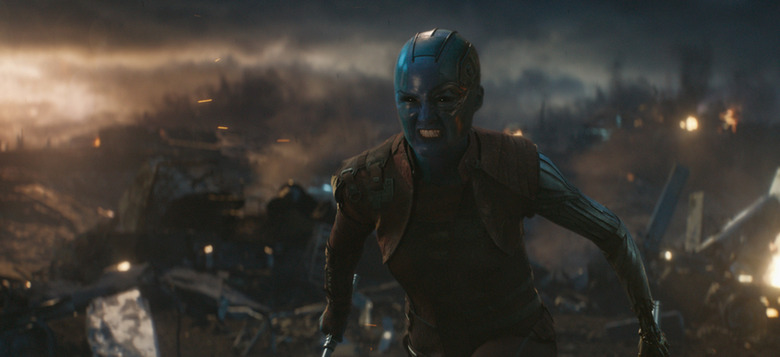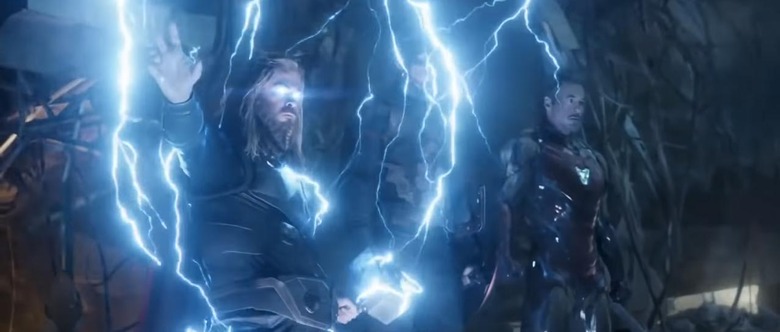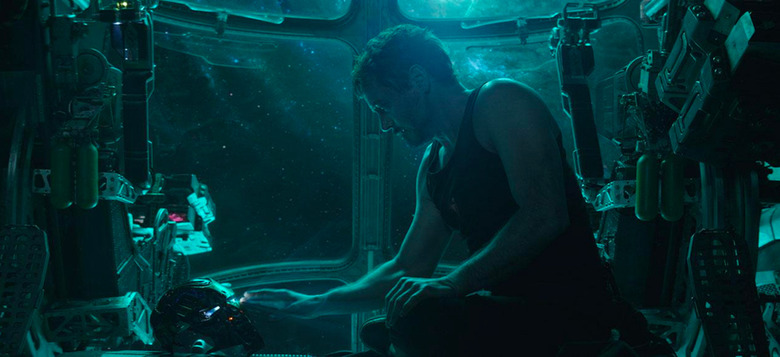Road To Endgame: 'Avengers: Endgame' Offers A Proper Goodbye At The End Of All Things
(Welcome to Road to Endgame, where we revisit the first 22 movies of the Marvel Cinematic Universe and ask, "How did we get here?" In part two of our look at Avengers: Endgame: where the film drops the ball, and where it soars)[Read part one of our Avengers: Endgame piece here.]Of the lingering questions posed by Avengers: Infinity War, how the Avengers would go about gathering the Infinity Stones was paramount. For the most part, Avengers: Endgame's answers are fun and cathartic — Steve Rogers fights his former self, while Thor and Tony Stark get closure with their parents — though one Stone in particular was destined to be dilemmatic. The last time around, Thanos sacrificed his own daughter Gamora to attain the Soul Stone ("A soul for a soul," as the Red Skull put it) in a film where the villain won through trading lives, but the heroes failed despite their numerous attempts to do so.The superhero trolley problem has reared its head throughout the series, most notably in Avengers: Age of Ultron ("Would you kill millions to save billions?") though earlier entries like Thor, Captain America: The First Avenger and even Doctor Strange hinged on heroes choosing the greater good over their individual lives. Sometimes, they did so in opposition to the villains' un-feeling utilitarianism, which sought to place an objective (and limited) value on human life, culminating in Thanos wiping out half the universe so the other half could thrive.Avengers: Endgame presents us with a Thanos pushed to a further extreme. Having seen the result of his plan, and the inability of the Avengers (and of humanity) to move on from failure, he now plots to use the Infinity Stones to wipe out life entirely, and start the universe from scratch. On the other side of this equation lie heroes who have no choice but to push through failure, no recourse but to sacrifice for the greater good, and no option but to pull off the impossible in order to restore balance.It doesn't always work — but when it does, it works like a charm.
Hawkeye
For years, the two least powerful Avengers have been especially interesting, since they're spies and assassins forced to fight alongside Gods and monsters. Outside of Thor, "the snap" seems to hit Hawkeye and Black Widow the hardest.Hawkeye/Clint Barton, after witnessing his wife and three children disappear in front of him, goes off the deep end. He spends five years in a mask and hood killing gang members the world over, though there's no indication of what good this might actually be doing. Both Barton and Romanoff are desperately in need of purpose. Barton, especially, feels like he has nothing to lose; during the team's time-travel experiments, he jumps in when Ant-Man doesn't feel ready, despite the risks at hand.Barton's desperation manifests further at the edge of the cliff on Vormir, where he and Romanoff have to decide which of them must die in order to attain the Soul Stone. It's a logical extension of Barton's arc thus far, and his fight with best friend Natasha Romanoff to see who gets to tumble off the ledge is a heart-pounding watch (not to mention a narrative mea culpa for their pulled punches in Captain America: Civil War). Ultimately, Barton is forced to endure the pain of yet another loss, as Romanoff forces him to stay alive for his family. Upon his return to the present, and after Banner uses the Infinity Stones, a call from Barton's wife signals the return of the billions killed by Thanos.Hawkeye, after keeping his family a secret, after losing them anyway, and after going so far astray that he may not have lived to see them again, comes back from the ledge and finds solace. Though unfortunately, Black Widow's arc isn't quite so neat, despite its heart-wrenching setup.
The Women of Marvel
Black Widow/Natasha Romanoff mopes around Avengers HQ disheveled; her meals consist of hastily thrown together peanut butter sandwiches, and she barely has time to take care of her hair or change out of sweatpants. When the diabetic optimism of Steve Rogers comes a-knocking, she slumps down in her chair. She's a mess, and throwing herself into her work is how she keeps her head above water.Romanoff's self-sacrifice can, on paper, be made to feel like the logical outcome of searching for purpose. Her predicament five years after "the snap" is rooted in losing half her family, and as a character who's spent numerous films using that family to try and find herself (in The Winter Soldier and Age of Ultron especially), that journey doesn't arrive at a satisfying conclusion when she throws herself off the cliff. She still hopes to wipe out the "red in [her] ledger," and dying to attain the Soul Stone does, mathematically, equal a debt paid. But where Hawkeye's readiness to give up and die is his entire through-line, Romanoff's sudden, un-questioning acceptance of this outcome for herself feels like the product of a deleted scene — especially since the duo's cliff-side battle positions them, through its visual language, as equal halves of this tête-à-tête. Hawkeye eventually finds himself again, but Black Widow isn't given the same luxury, despite her sacrifice.This outcome, while in perfect service of Barton's story, can't help but feel anti-climactic for Romanoff. What's more, it reduces the mechanics of the Soul Stone — "a soul for a soul" — to a literal act, while Thanos' sacrifice in Infinity War implicitly leaned towards destroying what was left of his own soul. In Endgame, two characters who have every reason to question their own goodness end up at this cliff, one of whom (Clint Barton) has already lost everyone he loves, and his very soul in the process. Though rather than examining this idea, the film remains satisfied with re-creating Gamora's death with nearly matching shots. As if the same exact scenario were repeating once more, rather than having the characters wrestle to find a different way out — or giving Romanoff a more tangible impetus for her sacrifice compared to Barton. Or, even compared to Tony Stark later in the film, who's spent most of its runtime weighing his own family against the greater good.As much of a blast as Endgame is, much of what doesn't work unfortunately manifests as female characters being given incomplete arcs, or moments that don't quite land as well as their male counterparts. Carol Danvers' arrival in the final battle, for instance, is a bizarre and weightless beat, given both her absence from the rest of the film, and her lack of dramatic connection to the characters and events on screen. Compare this, however, to the The Falcon/Sam Wilson announcing his arrival to Steve Rogers at a similar all-is-lost moment and the difference is clear, since the latter harkens back to an existing relationship.Nebula, having grown from a ruthless pawn into a caring hero, symbolically kills her past self the way Steve Rogers symbolically confronts his most naïve tendencies when he fights himself in 2012. Though the key difference is the literal consequence of killing the past Nebula, a real person, especially in a moment where she cries out that her father and abuser Thanos won't let her change. There are no time-travel ramifications to the present Nebula shooting her past self, since this doesn't impact her safety in the present. So this conclusion feels too narratively easy for the scenario — a confrontation between Gamora and both Nebulas that's only just begun — and it feels especially mean-spirited, given the past Nebula's final words. The ultimate irony is that it's the present Nebula, and not Thanos, that prevents the past Nebula from growing.However, where Avengers: Endgame succeeds is in having even its empty calories feel like hearty meals. While the beat of all the female Avengers assembling goes nowhere in particular — what little of note they achieve in the battle is lost amidst the chaos — the mere sight of them lined up and ready for war is imbued with enough momentum to elicit an uproarious response.Although, one such moment does, in fact, hold the emotional weight necessary to feel truly meaningful beyond momentary optics (and meta-textual concerns of representation). Despite entering late in the game, and despite being absent for about as long as Carol Danvers, Pepper Potts' arrival in her own Stark-created armour feels definitively earned — both from a series standpoint, since she's been instrumental in defeating the villains in every Iron Man film, and in the context of Avengers: Endgame.Pepper knows what's at stake, and she knows why Stark has to go off and save the day once more, since he won't find peace until he does. Only this time, she's made equal party to Stark's decision, rather than it being sprung on her all of a sudden, as it was in The Avengers and Avengers: Infinity War. In fact, she is what's at stake for Tony Stark, though she finally transcends this secondary role when she and Stark fight back to back. They float in mid-air while the camera gazes up at them, as they spin around each other and fire lasers at the alien hoardes — as if they're part of a a singular machine, and Pepper has finally forced Stark to let someone else into his cocoon.Avengers: Endgame was always going to live or die on the success of its final act. And while its numerous flaws detract from what could have been a pitch-perfect finale, the resultant climax is littered with rousing moments that make it one of Marvel's crowning achievements.
The Endgame
While the stakes are heavily implied amidst the Avengers' time-heist, they become tangible once the heroes snap their lost loved ones back into existence. We don't yet see them return — some are in different cities or countries, while others are on different planets — though Laura Barton's phone call, and Clint Barton's overwhelming sense of relief, are reason enough to believe the heroes have won. That is, until Thanos arrives from the past, with foreknowledge of events and a more destructive goal. Mere seconds after their apparent victory, the Avengers' headquarters is reduced to rubble.Once they push their way out from under the debris, Hawkeye attempts to get the new Infinity Gauntlet to safety, while the lead trio (Iron Man, Captain America and Thor) confronts the Mad Titan. Captain America even lifts Thor's hammer, one of two Thor wields in the scene.Rogers lifting Mjolnir is a magnificent sequence, and one we'd all come to expect and hope for ever since Avengers: Age of Ultron, though I can't help but throw in some wishful thinking in that same vein. There was never any doubt that Steve Rogers would be "worthy" enough to wield the hammer. However a character like Black Widow — the only person who didn't attempt to lift Mjolnir in Ultron, for fear of it proving her worthlessness — may have needed this culmination a little more from a story standpoint, given her arc across the series. Still, once the characters are beaten down and nearly defeated, and Thanos' gargantuan army arrives, the scene's payoffs continue. While Black Panther, Shuri and Okoye are the first to arrive through Doctor Strange's portal — during sunset in Wakanda, making their glowing silhouettes resemble a heavenly resurrection — how the arrival is actually signaled makes all the difference. Were it announced by any other character, it would've felt as empty and incidental as Carol Danvers' return later on. Though the first voice we hear belongs to Sam Wilson, with whom Rogers has a more dramatically established relationship than anyone else (including Bucky, unfortunately). Wilson's callback to their playful first interaction — "On your left" — signifies not only the return of lost characters, but lost friends, as does the teary-eyed relief on Rogers' face.On the downside, this same care isn't afforded to other major reunions that take center stage. While Scott Lang is given a quiet beat where he stands alongside Hope Van Dyne, the woman he loves, he gives her a casual smile as if greeting her after a few hours apart. This is the same characters whose death is fresh in his mind (he only found out about it a few weeks prior) and his uncharacteristic anger in the film makes it seem like he's struggling to work through it. Similarly, Rocket's moment alongside lifelong friend Groot, who died horribly in front of Rocket five years ago, doesn't even involve the two looking at one another. Rather, it's used as a reaction shot for the arrival of Carol Danvers, a character we've barely seen either one interact with.These moments can't help but feel similar to the deaths in Avengers: Infinity War. Some reunions matter. Tony Stark hugging a returned Peter Parker is an applause moment on its own; their relationship is re-established earlier in the film, when Stark looks at their goofy photograph. Other moments don't seem to hold nearly the same weight — like Wong greeting a resurrected Doctor Strange with a joke — as if the actors, once again, weren't told exactly what they were filming.However, the way the battle plays out helps spackle over these problems in-the-moment. It kicks off with the arrival of nearly every group we've met in the series thus far, from the sorcerers in Doctor Strange, to the Asgardians in Thor, to the Wakandans in Black Panther, to the Ravagers in Guardians of the Galaxy, followed by snapshot of the entire battlefield. While directors Joe & Anthony Russo have often had trouble portraying scale — Thanos throwing an entire moon at the Avengers in Infinity War is bigger on paper than in practice — the picture they paint in Endgame feels akin to a religious epic, with a giant Scott Lang in the background, and light from each of Strange portal's shining onto the battlefield, as if to combat the darkness.It's Hieronymus Bosch by way of Alex Ross.Though rather than letting its characters run amok immediately, the film subsequently zeroes in on Captain America, allowing him to deliver his iconic line from the comics and kick off the battle: "Avengers... Assemble!"What follows is the Russos finally approaching Joss Whedon's visual panache, albeit imperfectly. As if to bring the heroes full circle, back to The Avengers and Avengers: Age of Ultron, they battle in several long-takes as the camera shifts focus from one character to the next, switching between them in fluid motion as if to capture a well-oiled machine. While it still suffers from the major problems with the action in Infinity War — there's no coherent sense of geography or physical relationship between anyone the battle and the Gauntlet, or between the Gauntlet and the time machine — the chaotic, desperate nature of the fight still feels fitting.Minor moments become major callbacks, from Spider-Man activating his "instant kill" (which he refused to in Spider-Man: Homecoming), to Black Panther recognizing Clint Barton and calling on him as an ally (after originally responding to his introduction with "I don't care" when they fought in Captain America: Civil War). Even the conclusion to the battle involves Tony Stark calling back to his first film, as he firmly re-establishes his heroism after having given up earlier on; Stark responds to Thanos' "I am inevitable" with the line "And I am Iron Man," before snapping his fingers, Infinity Stones in hand.As the invading aliens are reduced to dust, Stark gets his heroic send-off. Pepper Potts, knowing full well the burden that has just been lifted, tells Stark he can finally rest. For all the messiness that led up to it — both in Avengers: Endgame, and in the series at large — it's a conclusion well-earned.
Saying Goodbye
The biggest surprise in Avengers: Endgame — albeit a pleasant one! — is that its final battle concludes nearly twenty minutes before it ends. In the meantime, we're shown glimpses of global peace and celebration (a la the special edition of Star Wars: Return of the Jedi) as Tony Stark plays us out via posthumous voiceover, later revealed to be a recording for his family. After Avengers: Infinity War called into question his ability to protect people, both as a hero and as a parent, he leaves the world better than he found it for his daughter Morgan, as the lingering impact of the saga is delivered in waves of quiet moments.While Stark gets a fitting funeral rife with references to prior films — Pepper's "Proof that Tony Stark has a heart" memento, the presence of Harley Keener from Iron Man 3, Morgan asking Happy Hogan for a cheeseburger as Stark once did — it's unfortunate that Natasha Romanoff's on-screen memorializing is reduced to a singular conversation, despite her sacrifice being just as vital. Still, the exchange between Hawkeye and a returning Wanda Maximoff captures the emotional aftermath with precision, as they each wish there were a way for their fallen comrades (Black Widow and The Vision) to know their sacrifices weren't in vain. While the heroes have undone their major failures, the emotional devastation of loss remains. Though, perhaps the most satisfying part of the film's conclusion comes with Steve Rogers' sly return to 1945 to reunite with Peggy Carter. It's the most surprising of the film's subversions, since Rogers — a soldier, stuck not only out of time, but in perpetual war — finally acts out of selfishness rather than altruism, as if to mirror Stark's opposing journey one final time. Though it's a conclusion Rogers writes for himself both after saving everyone else, and after accepting that a normal, peaceful life is something he's still capable of.Captain America, a man born into war and bred for conflict, finds love and happiness despite the horrors he's seen. He re-appears to the team eight decades later, as an old man, and hands his shield down to his friend Sam Wilson, after living a full and beautiful life.For characters so shackled by their pasts, there's no happier ending.




